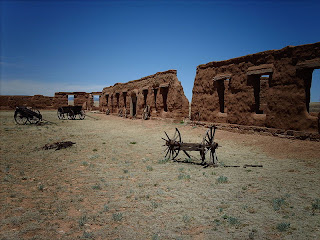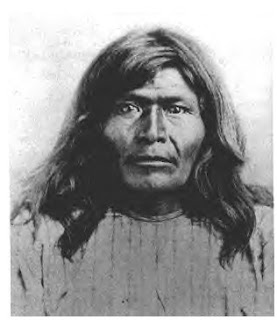 |
| Courtesy National Parks, CC ShareAlike2.5 |
Like all western military forts, the purpose was for protection. Protection for the settlers and for the local populace. Fort Union was in a very strategic place, along the much traveled mountain route of the Santa Fe Trail. It was the main supply depot for goods coming into the New Mexico Territory. Located 8 miles northwest of Watrous New Mexico, Fort Union was at one time home to the Buffalo Soldiers when the cavalry and infantry units were established after the Civil War.
The Buffalo Soldiers served in several forts in New Mexico and to say they saw a lot of action is really an understatement. Among the New Mexico Territory forts where the Buffalo Soldiers served, five were built prior to the Civil War, four during the war and two after the wars end. Who are the Buffalo Soldiers and what was their history in the American West? It's an interesting story of bravery under adverse conditions.
The Establishment of the Buffalo Soldier Regiments
Both free northern blacks and former southern slaves were sought out by Uncle Sam to help in the Union cause. Regarding the Buffalo Soldiers history, some statistics regarding African-Americans during the Civil War are quite interesting and perhaps not well publicized. Various northern states organized black regiments during 1863 and 1864. There was a lot of debate about this caused mostly by racial prejudice. Many in the north simply felt that the U.S. Army should be a white army. Regardless, President Lincoln signed an act that led to formation of black units. The number of black men who the Union enlisted during the Civil War totaled near 200,000. Black troops fought in no less than 449 engagements stretching from the east all the way to the western frontier. Before the war ended, there were twenty-nine volunteer black regiments and the Army itself fielded 130 black infantry regiments. In 1864 these regiments were officially called the "U.S. Colored Troops".
 |
| Ninth Cavalry Buffalo Soldier, 1890 |
Again, regardless of the debate, the Army was given permission in 1866 to organize African-American regiments. It was well understood that when the Civil War ended there would be a great need for troops on the western frontier. This was made quite clear by the Indian depredations that occurred in the west during the war when so many of the troops were sent back east. While the African-American regiments made great contributions for the Union during the war, they would make similar contributions protecting settlers and railroad construction crews in the west.
Frontier Life of the Buffalo Soldier
The Buffalo Soldiers had a much rougher time in general than white soldiers, especially in places like New Mexico. The white troops were generally held in lower esteem by much of the local populace because they were soldiers. The black troops had to endure this level disrespect and even more because of their skin color. Things could get a bit testy when Buffalo Soldiers made their presence known in towns with a Confederate secessionist history. This was very true in areas of Texas where the black troops did have a big presence at Fort Davis and Fort Concho. See our Western Trips articles on these two forts on the links below.
Fort Davis and Fort Concho.
The Buffalo Soldiers were involved in many things while stationed in New Mexico. Not all things had to do with glorious battles. Duty included normal patrols searching for renegade Indians, offering protection to stage and freight lines and of course protecting the railroad building crews not to mention town folk and travelers. Two very significant events took place in New Mexico where their involvement was especially noted. That was the campaign against the renegade Apache Chief Victorio. The other, and this link will take you to our article, was the infamous Lincoln County Wars.
 |
| Apache Chief Victorio |
New Mexico Action
The start of what was referred to as Victorio's War was when the Apache Chief left the San Carlos Reservation in 1877. What ensued were a few years of raids and killings by Victorio's forces. The Buffalo Soldiers who had been stationed at Fort Stanton, Fort Bayard and Fort Seldon in southern New Mexico spent many months on the hunt for Victorio. Several Buffalo Soldiers were killed in this long campaign. It was a dangerous business and required much discipline. A big problem with pursuing renegades like Victorio and Geronimo was that they could skip over the Mexican border and the U.S. legally could not cross after them.
The U.S. and Mexico had been trying to negotiate an agreement but with no progress. The Mexican citizenry was also attacked by the renegade bands and the Mexican military also pursued them. That being said, there were instances where the cavalry rode into Mexico in pursuit of Indian leaders such as Geronimo.
Eventually Victorio surrendered at the Mescalero Apache Agency but as he had done previously, he bolted. When Victorio started raiding again in New Mexico in January 1880, the Ninth Cavalry Buffalo Soldiers were sent out again in pursuit. Raids and engagements occurred during the spring and summer with Victorio many times taking refuge in the mountains. His victims typically were ranchers and miners found in isolated areas. After many months of hit and run attacks, Victorio was finally engaged and killed in September 1880 much to the relief of New Mexico's settlers.
Another more touchy matter with the use of Buffalo Soldiers occurred in Lincoln County New Mexico. This incident didn't involve Native Americans. It involved a quarrel between white men. Lincoln County New Mexico in 1869 was a large unsurveyed area comprising most of southeastern New Mexico Territory. Since that time the county has been divided into several smaller counties. The area was used for cattle grazing and as you might imagine it was also home to many strange characters. Cattle ranchers, farmers, merchants, cowboys, soldiers, Indians, general outlaws and of course cattle rustlers. The area was so unstable during the 1870's that even the nearby Mescalero Apaches on their reservation had a difficult time keeping safe.
The Lincoln County Wars
 |
| Basic map of Lincoln in 1870's.Pecos River to north. Wikipedia |
Billy The Kid was aligned with the newer faction, the McSween-Tunstall group, and supposedly was directly involved in several shootings. Billy the Kid was responsible for shooting the newest sheriff William Brady. Also, a local lawyer who was working for the new faction was gunned down on the streets of Lincoln. This crime was thought to be committed by hired guns of the Murphy group. Troops from nearby Fort Stanton were drawn into the war by the next sheriff. Acting on his request a detachment from nearby Fort Stanton was given the go ahead by military superiors in Santa Fe as well as by the territorial governor. During this first request for assistance, mostly because of the heated atmosphere the troops stayed just outside of town. There presence was known to all but there were no confrontations. The troops then withdrew back to Ft. Stanton.
It was reported that everything later came to a head when McSween entered Lincoln with about 40 gunmen. McSween (Tunstall had already been murdered earlier by a sheriff's posse supposedly on orders from Murphy) was in his home with his wife and about 15 to 20 gunmen.
Other gunmen for both sides were stationed on top of adobe structures. What ensued were several days of sporadic gunfire between the McSween men and the sheriff and Murphy gunmen. The sheriff, being somewhat aligned with the Murphy group, asked Lt. Colonel Dudley at Ft. Stanton for a howitzer. Dudley refused the request. Later on, another request by then sheriff Peppin (the current sheriff) asked that the military again intervene. This happened at about the same time a plea for military assistance to end the violence was made by a group of local Mexican women. Lt. Colonel Dudley, in charge at the fort, sent troops to Lincoln once again including his Buffalo Soldiers. Dudley sent these troops even though his superiors had told him to now stay out of any civilian matters in Lincoln. A lot of politics were involved.
 |
| Pat Garrett |
About a dozen Buffalo Soldiers who were stationed at Ft. Stanton were sent to Lincoln by Dudley with their white officers and other troops to help restore some order. Some show of force seemed to be needed. What transpired next was sometime disputed depending on who told the tale. While the Buffalo Soldiers were in the center of town the gunfire still continued around the McSween house.
Sheriff Peppin had an arrest warrant for McSween but obviously couldn't serve it. The house was eventually set on fire by Peppin's men. McSween was shot and killed during the exchange and Billy the Kid and others escaped out the back. The Buffalo Soldiers were sent on a few different missions to capture the Kid but were unsuccessful. Billy the Kid was eventually arrested by Pat Garrett for Brady's murder and was later killed by Garrett after his trial and after escaping from jail.
The Buffalo Soldiers served in many areas of the frontier west and they served very well just as they had during the Civil War days. While they haven't seemed to gain the same fame as soldiers like George Armstrong Custer and General Phillip Sheridan, their story has been coming out and publicized a bit more. The Buffalo Soldiers daily routine was every bit the same as other U.S. Army troops. In addition to the dangerous pursuit of renegade Indians the Buffalo Soldiers did the routine duty of building shelters, escorting stage coaches and freighters and keeping the infrastructure of the fort running.
The Fort Union National Monument could be a good addition to your New Mexico vacation planner. The site is located 94 miles north of Santa Fe New Mexico. Take Interstate-25 north to exit 366 in Watrous New Mexico and go about 8 miles on NM Rte 161. From Colorado Springs Colorado take I-25 south to exit 366.
(Article copyright Western Trips. Photos and images in the public domain)
BUFFALO SOLDIER TIMELINE VIDEO

